DOI:
10.1039/D3RA07513C
(Paper)
RSC Adv., 2024,
14, 1741-1749
Solution combustion synthesis of MgO-stabilized CaO sorbents using polyethylene glycol as fuel and dispersant
Received
3rd November 2023
, Accepted 27th December 2023
First published on 8th January 2024
Abstract
The main limit for the calcium looping process is the sharp decrease of the capture capacity of the CO2 sorbents during multiple cycles. In this research, a solution combustion method was employed to synthesize MgO-stabilized CaO sorbents. Polyethylene glycol (PEG) was used as the fuel and dispersant, with the purpose to enhance the uniformity of the Ca and Mg distributions in the sorbent. The results show that highly reactive MgO-stabilized CaO sorbents can be obtained through a solution combustion method using PEG as the fuel and dispersant. The existence of MgO can effectively restrain the sintering of the sorbent, resulting in a more porous and stable micro-structure of the sorbent. The CO2 capture capacity of the MgO-stabilized CaO sorbent synthesized under the optimum conditions is 0.40 g(CO2)/g(sorbent) after 20 cycles, which is 75.3% higher than CaCO3.
1. Introduction
In response to global climate change, the Chinese government has promised the world to reach its carbon peak by 2030 and achieve carbon neutrality by 2060.1 To this end, it is of utmost importance and a significant challenge to promote CO2 capture from the major emission sources.2 The calcium looping process (CLP), which is based on the reversible carbonization reaction of lime, was proposed as a feasible and effective post-combustion CO2 capture technology.3 As shown in Fig. 1, this process is achieved in a dual circulating fluidized bed reactor system, including a carbonator and a calciner. Limestone is firstly calcined in the calciner at around 900 °C and decomposed to CaO and CO2. The formed CaO is then delivered to the carbonator to capture the CO2 in flue gas at around 650–700 °C, at which temperature about 90% CO2 capture efficiency is achieved. A CO2 free flue gas is obtained at the outlet of the carbonator after gas–solid separation. Then the separated CaCO3 formed by carbonation in the carbonator is delivered to the calciner to be calcined again. The energy needed in the calciner is provided by oxy-fuel combustion. Therefore, the CO2 concentration in the flue gas at the outlet of the calciner can be higher than 95%, at which concentration the CO2 can be directly sent for storage. A key advantage of CLP over other CO2 capture technologies is the utilization of natural limestone or dolomite which have low costs, widespread availability and non-toxicity to the environment.4 Industrial solid wastes such as carbide slag5 and lime mud6 were also proposed as CO2 sorbents. Therefore, CLP was considered as one of the most promising technologies to reach large scale CO2 emission reduction from coal-fired power plants.7 The main limit for CLP is the sharp decrease of the capture capacity of the CO2 sorbents with increasing the number of the calcination/carbonation cycles.8 This is mainly due to the sintering occurred in the calcination stage under relatively high temperature,9 while the carbonation process has little effect on the sintering of the sorbents.10 In order to approach full calcination of the sorbent under high concentration CO2, calcination required significantly higher temperatures (900–1000 °C), resulting in changes in pore shape, pore shrinkage and grain growth.11 More CO2 sorbent has to be added in the reactor to guarantee high enough CO2 capture efficiency, which leads to more serious abrasion.
 |
| | Fig. 1 Flow diagram of calcium looping process. | |
A lot of efforts have been made to enhance the anti-sintering characteristics and increase the CO2 capture capacity of the natural sorbents. It has been proved that modification by organic acid,12 ball milling,13 hydration treatment,14 mixing of a small amount of additives15 and synthesis of precipitated calcium carbonate16 can obviously increase the cyclic carbonation conversions during multiple cycles. However, these treatment methods can only optimize the initial microstructure of the calcined sorbent, with little help to the anti-sintering characteristics of the sorbent. Therefore, the treated sorbents still shows relatively fast decay on CO2 capture capacity. In comparison, inert material supported synthetic sorbents show much better cycle stability. The inert materials such as Mg17 and Al18 in the synthetic sorbents can effectively inhibit the growth and fusion of the CaO grain when calcined at high temperature, resulting in stable microstructure during multiple cycles. It is the main mechanism why the synthetic sorbents can achieve higher CO2 capture capacity. It has been proved that TiO2, MgO, La2O3, ZrO2, SiO2 and Al2O3 are effective inert materials.19 Thereinto, MgO has drawn extensive attentions due to its low cost and wide distribution in natural world. The synthesis methods and the MgO precursors have significant effects on the CO2 capture capacity of the synthetic sorbents. The CaO–MgO sorbent synthesized by mechanical mixing using insoluble MgO precursors shows a little higher cyclic carbonation conversion than natural Ca-based sorbents.20 When synthesized by sol–gel method using soluble CaO and MgO precursors, the synthetic sorbents show the highest CO2 capture capacity.7 However, the synthesis cost is relatively high, limiting its industrialized application. Using Ca(NO3)2 and Mg(NO3)2 as CaO and MgO precursors, Naeem et al.21 yielded highly effective CaO–MgO sorbents via a hydrothermal approach. They also found that the presence of a carbonaceous template during synthesis allowed for the formation of multi-shelled microstructures.
Among all the synthesis methods, solution combustion method is a kind of facile one-pot synthesis approach to obtain highly effective synthetic sorbents with stable CO2 capture capacity.22 Using carbide slag as the CaO precursor, dolomite as the MgO precursor and trace Mn as the dopant, Ma et al.23 synthesized a novel Mn/Mg-copromoted carbide slag via a solution combustion method. The byproduct of biodiesel was used as the solvent and fuel, leading to even lower synthesis cost. The yielded sorbents achieved a CO2 capture capacity of 0.52 g g−1 after 10 cycles, which was 82% higher than that of carbide slag. The supplement ratio of CaO in calcium looping process is only 3% mole ratio of CO2 in the flue gas. Although there is a certain amount CO2 released during the solution combustion process, compared with the CO2 amount that can be captured by the calcium based sorbent, the CO2 amount that released during the synthesis process can be ignored. Also, the CO2 released during the synthesis process can be delivered into the carbonator of the CLP process to be captured, avoiding the CO2 emission by synthesis process. By capturing the undesirable CO2 released from the synthesis process through CLP process, the solution combustion synthesis methods can be eco-friendly when synthesizing the CaO–MgO sorbents. Polyethylene glycol (PEG) is a kind of organic polymer that is widely used as dispersant in chemical industry. For example, as binder for dispersed phases, PEG was often used in propellant formulations since it well maintains viscoelastic behaviour undergone stretch.24 In this research, polyethylene glycol was employed as the fuel to synthesize the highly reactive CaO–MgO sorbents by solution combustion method, with the purpose to enhance the dispersion of Mg and Ca in the synthetic sorbents.
2. Sorbents and experiments
2.1. Sorbents preparation
All the reagents used in this research were analytically pure from Titan Technology Co., Ltd (Shanghai, China). Ca(NO3)2 and Mg(NO3)2 were employed as CaO and MgO precursors. Polyethylene glycol was employed as fuel and dispersant. The molecular weight of the polyethylene glycol used here was 200–1500. The synthesis process of the CaO–MgO sorbent by solution combustion method was shown in Fig. 2. A certain amount of deionized water and polyethylene glycol were firstly added into a beaker, and then the solution was heated to 80 °C. After that, Ca(NO3)2 and Mg(NO3)2 were put into the beaker. The solution was stirred in a magnetic stirrer until all materials were dissolved. Then, the solution was poured into the porcelain boat and sent to the muffle furnace for combustion synthesis. The CaO–MgO sorbents were obtained after calcination at 700–850 °C for 30–120 min. The detailed experimental settings were shown in Table 1. The synthetic CaO–MgO sorbent was sent for XRD analysis to check the compounds. As shown in Fig. 3, the main compounds of the CaO–MgO sorbents were CaO and MgO. No other compound was found through the XRD results. As the contrast sample, the CaO from calcination of CaCO3 was defined as CaO–C.
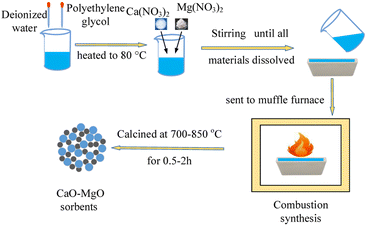 |
| | Fig. 2 Synthesis process of the CaO–MgO sorbent by solution combustion method. | |
Table 1 Details of the experimental settings
| No. |
Molar ratio of Ca/Mg |
Weight of Ca(NO3)2·4H2O (g) |
Weight of Mg(NO3)2·6H2O (g) |
Weight of PEG (g) |
Weight of distilled water (g) |
Molecular weight of PEG (g mol−1) |
Synthesis temperature (°C) |
Synthesis time (min) |
| 1 |
7![[thin space (1/6-em)]](https://www.rsc.org/images/entities/char_2009.gif) : :![[thin space (1/6-em)]](https://www.rsc.org/images/entities/char_2009.gif) 3 3 |
41.33 |
19.23 |
100 |
100 |
600 |
750 |
60 |
| 2 |
8![[thin space (1/6-em)]](https://www.rsc.org/images/entities/char_2009.gif) : :![[thin space (1/6-em)]](https://www.rsc.org/images/entities/char_2009.gif) 2 2 |
47.23 |
12.82 |
100 |
100 |
600 |
750 |
60 |
| 3 |
9![[thin space (1/6-em)]](https://www.rsc.org/images/entities/char_2009.gif) : :![[thin space (1/6-em)]](https://www.rsc.org/images/entities/char_2009.gif) 1 1 |
53.13 |
6.41 |
100 |
100 |
600 |
750 |
60 |
| 4 |
7![[thin space (1/6-em)]](https://www.rsc.org/images/entities/char_2009.gif) : :![[thin space (1/6-em)]](https://www.rsc.org/images/entities/char_2009.gif) 3 3 |
41.33 |
19.23 |
100 |
100 |
200 |
750 |
60 |
| 5 |
7![[thin space (1/6-em)]](https://www.rsc.org/images/entities/char_2009.gif) : :![[thin space (1/6-em)]](https://www.rsc.org/images/entities/char_2009.gif) 3 3 |
41.33 |
19.23 |
100 |
100 |
1500 |
750 |
60 |
| 6 |
7![[thin space (1/6-em)]](https://www.rsc.org/images/entities/char_2009.gif) : :![[thin space (1/6-em)]](https://www.rsc.org/images/entities/char_2009.gif) 3 3 |
41.33 |
19.23 |
100 |
100 |
600 |
700 |
60 |
| 7 |
7![[thin space (1/6-em)]](https://www.rsc.org/images/entities/char_2009.gif) : :![[thin space (1/6-em)]](https://www.rsc.org/images/entities/char_2009.gif) 3 3 |
41.33 |
19.23 |
100 |
100 |
600 |
850 |
60 |
| 8 |
7![[thin space (1/6-em)]](https://www.rsc.org/images/entities/char_2009.gif) : :![[thin space (1/6-em)]](https://www.rsc.org/images/entities/char_2009.gif) 3 3 |
41.33 |
19.23 |
100 |
100 |
600 |
750 |
30 |
| 9 |
7![[thin space (1/6-em)]](https://www.rsc.org/images/entities/char_2009.gif) : :![[thin space (1/6-em)]](https://www.rsc.org/images/entities/char_2009.gif) 3 3 |
41.33 |
19.23 |
100 |
100 |
600 |
750 |
120 |
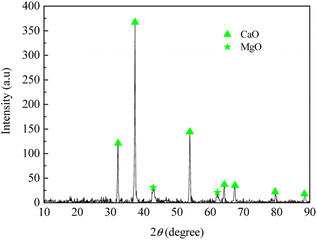 |
| | Fig. 3 XRD analysis of the synthetic CaO–MgO sorbent. | |
2.2. Cyclic calcination/carbonation tests
As shown in Fig. 4, the cyclic calcination/carbonation tests of the sorbent were accomplished in a dual fixed bed reactor (DFR), which was detailed elsewhere.25 The N2 and CO2 feed were controlled by mass flow controllers and introduced into the reactor. The sample was firstly calcined for 10 min at 850 °C in pure N2 and then was carbonated for 10 min at 700 °C in 15% CO2 (balanced by N2). Li et al.26 has proved that the optimum carbonation time for calcium based sorbent is 650–700 °C. Criado et al.27 attributed the lower conversion under lower carbonation temperature to product layer thickness decreases in accordance with an Arrhenius dependence. Therefore, the carbonation temperature chosen in this manuscript is 700 °C.
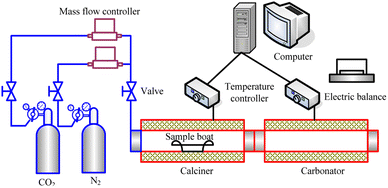 |
| | Fig. 4 Schematic diagram of dual fixed-bed reactor (DFR). | |
Carbonation conversion (XN) and CO2 capture capacity (CN) were employed to reflect the CO2 capture performance of the sorbents. Carbonation conversion denotes conversion of CaO in the sorbent to CaCO3, mol mol−1. CO2 capture capacity indicates CO2 adsorption amount per unit mass of sample, g(CO2)/g(sorbent). The sample mass after calcination and carbonation were measured by an electronic balance, and the XN and CN were calculated according to the mass change during the carbonation and calcination stage, as shown in equal (1) and (2).
| |
 | (1) |
| |
 | (2) |
where
m0 is the initial mass of the sample, mg;
mN is the mass of the carbonated sample after
N cycles, mg;
mcal is the mass of the completely calcined sample (the mass of the sample after each calcination is the same), mg;
MCaO and
MCO2 are molar masses of the CaO and CO
2 respectively, g mol;
a is the content of CaO in the initial sample, %.
2.3. Microstructure analysis
The samples of CaO–C and CaO–MgO sorbent were collected and sent for SEM and EDS analysis (Hitachi, Regulus8100), to determine the micro morphology and the distribution of element. The pore volume and pore area distributions of the CaO–C and CaO–MgO sorbents after different cycles were examined by a nitrogen adsorption analyzer (Micromeritics, ASAP 2020-M). The pore volume and pore size distribution of the sample were computed by BJH model, the BET surface of the sample was calculated by BET model.
3. Results and discussions
3.1. Effect of the MgO content on CO2 capture capacity
With the Ca/Mg molar ratio ranging from 9![[thin space (1/6-em)]](https://www.rsc.org/images/entities/char_2009.gif) :
:![[thin space (1/6-em)]](https://www.rsc.org/images/entities/char_2009.gif) 1 to 7
1 to 7![[thin space (1/6-em)]](https://www.rsc.org/images/entities/char_2009.gif) :
:![[thin space (1/6-em)]](https://www.rsc.org/images/entities/char_2009.gif) 3, the MgO-stabilized CaO sorbents were synthesized by solution combustion method. The solution combustion synthesis temperature and time were 750 °C and 60 min and the molecular weight of the polyethylene glycol is 600 in this case. The DFR test results were shown in Fig. 5. It can be seen that the MgO-stabilized CaO sorbents shows much higher and more stable CO2 capture capacity compared with that of the CaO–C. In the 20th cycle, the carbonation conversions of the MgO-stabilized CaO sorbents were 0.57, 0.53 and 0.42 when the Ca/Mg molar ratio were 7
3, the MgO-stabilized CaO sorbents were synthesized by solution combustion method. The solution combustion synthesis temperature and time were 750 °C and 60 min and the molecular weight of the polyethylene glycol is 600 in this case. The DFR test results were shown in Fig. 5. It can be seen that the MgO-stabilized CaO sorbents shows much higher and more stable CO2 capture capacity compared with that of the CaO–C. In the 20th cycle, the carbonation conversions of the MgO-stabilized CaO sorbents were 0.57, 0.53 and 0.42 when the Ca/Mg molar ratio were 7![[thin space (1/6-em)]](https://www.rsc.org/images/entities/char_2009.gif) :
:![[thin space (1/6-em)]](https://www.rsc.org/images/entities/char_2009.gif) 3, 8
3, 8![[thin space (1/6-em)]](https://www.rsc.org/images/entities/char_2009.gif) :
:![[thin space (1/6-em)]](https://www.rsc.org/images/entities/char_2009.gif) 2 and 9
2 and 9![[thin space (1/6-em)]](https://www.rsc.org/images/entities/char_2009.gif) :
:![[thin space (1/6-em)]](https://www.rsc.org/images/entities/char_2009.gif) 1, while the value for CaO–C was only 0.29. Take the MgO-stabilized CaO sorbent with Ca/Mg molar ratio is 7
1, while the value for CaO–C was only 0.29. Take the MgO-stabilized CaO sorbent with Ca/Mg molar ratio is 7![[thin space (1/6-em)]](https://www.rsc.org/images/entities/char_2009.gif) :
:![[thin space (1/6-em)]](https://www.rsc.org/images/entities/char_2009.gif) 3 as example, the SEM and EDS analysis were conducted to determine the element distribution on the surface of the sorbent, as shown in Fig. 6. The SEM analysis result shown in Fig. 6(a) was employed to calculate the EDS spectrum and the result was shown in Fig. 6(d). According to the EDS spectrum, the Ca/Mg molar ratio on the surface of the sorbent was calculated as 6.95
3 as example, the SEM and EDS analysis were conducted to determine the element distribution on the surface of the sorbent, as shown in Fig. 6. The SEM analysis result shown in Fig. 6(a) was employed to calculate the EDS spectrum and the result was shown in Fig. 6(d). According to the EDS spectrum, the Ca/Mg molar ratio on the surface of the sorbent was calculated as 6.95![[thin space (1/6-em)]](https://www.rsc.org/images/entities/char_2009.gif) :
:![[thin space (1/6-em)]](https://www.rsc.org/images/entities/char_2009.gif) 2.97, which was agree with the synthesis process. It proved that the EDS result was accurate. The Ca and Mg distributions on the sorbent surface were shown in Fig. 6(b) and (c). It revealed a homogeneously evenly distribution of Ca and Mg on the surface of the sorbent. As shown in Fig. 7, the calcined MgO-stabilized CaO sorbents showed more porous microstructure compared with the CaO–C during the 1st cycle. The existence of MgO can effectively restrain the sintering of the sorbent. As shown in Fig. 8, the calcined MgO-stabilized CaO sorbents can maintain effective enough pore structure for CO2 diffusion in the sorbent, while CaO–C occurred obvious sintering after 20 cycles. Thus, the MgO-stabilized CaO sorbents showed higher and more stable CO2 capture capacity compared with CaO–C.
2.97, which was agree with the synthesis process. It proved that the EDS result was accurate. The Ca and Mg distributions on the sorbent surface were shown in Fig. 6(b) and (c). It revealed a homogeneously evenly distribution of Ca and Mg on the surface of the sorbent. As shown in Fig. 7, the calcined MgO-stabilized CaO sorbents showed more porous microstructure compared with the CaO–C during the 1st cycle. The existence of MgO can effectively restrain the sintering of the sorbent. As shown in Fig. 8, the calcined MgO-stabilized CaO sorbents can maintain effective enough pore structure for CO2 diffusion in the sorbent, while CaO–C occurred obvious sintering after 20 cycles. Thus, the MgO-stabilized CaO sorbents showed higher and more stable CO2 capture capacity compared with CaO–C.
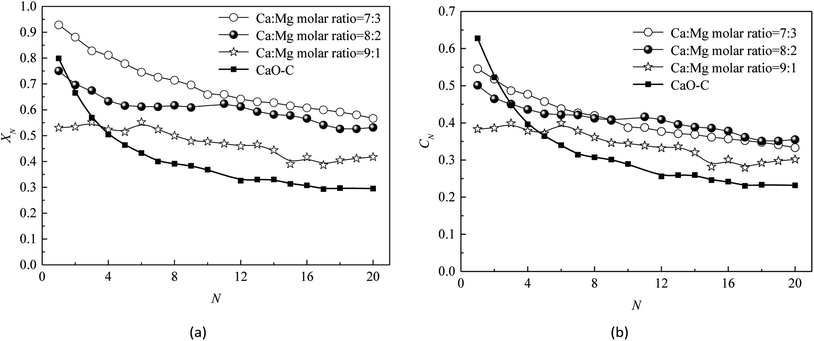 |
| | Fig. 5 Effect of the MgO content on the (a) carbonation conversion and (b) CO2 capture capacity of the MgO-stabilized CaO sorbent. | |
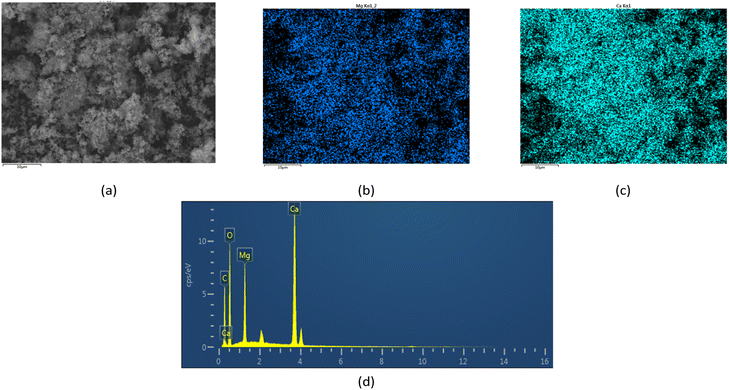 |
| | Fig. 6 SEM and EDS analysis of the calcined MgO-stabilized CaO sorbent with the Ca/Mg molar ratio is 7![[thin space (1/6-em)]](https://www.rsc.org/images/entities/char_2009.gif) : :![[thin space (1/6-em)]](https://www.rsc.org/images/entities/char_2009.gif) 3 (a) SEM imagine; (b) Mg distribution; (c) Ca distribution; (d) EDS spectra. 3 (a) SEM imagine; (b) Mg distribution; (c) Ca distribution; (d) EDS spectra. | |
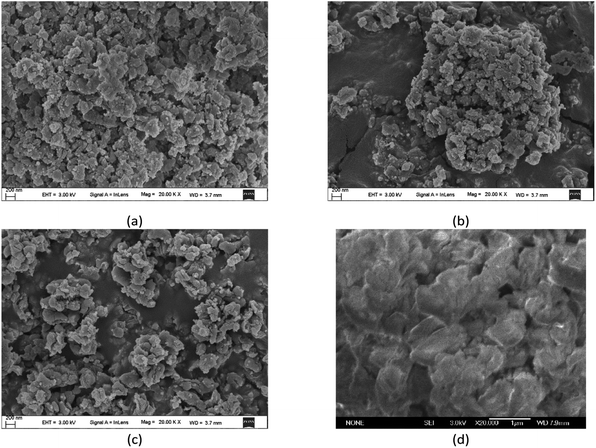 |
| | Fig. 7 SEM analysis of the calcined (a–c) MgO-stabilized CaO sorbent and (d) CaO–C in the 1st cycle: (a) Ca/Mg molar ratio is 7![[thin space (1/6-em)]](https://www.rsc.org/images/entities/char_2009.gif) : :![[thin space (1/6-em)]](https://www.rsc.org/images/entities/char_2009.gif) 3; (b) Ca/Mg molar ratio is 8 3; (b) Ca/Mg molar ratio is 8![[thin space (1/6-em)]](https://www.rsc.org/images/entities/char_2009.gif) : :![[thin space (1/6-em)]](https://www.rsc.org/images/entities/char_2009.gif) 2; (c) Ca/Mg molar ratio is 9 2; (c) Ca/Mg molar ratio is 9![[thin space (1/6-em)]](https://www.rsc.org/images/entities/char_2009.gif) : :![[thin space (1/6-em)]](https://www.rsc.org/images/entities/char_2009.gif) 1. 1. | |
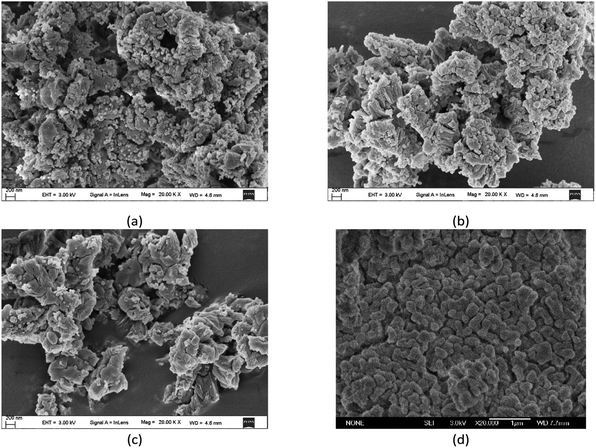 |
| | Fig. 8 SEM analysis of the calcined (a–c) MgO-stabilized CaO sorbent and (d) CaO–C after 20 cycles: (a) Ca/Mg molar ratio is 7![[thin space (1/6-em)]](https://www.rsc.org/images/entities/char_2009.gif) : :![[thin space (1/6-em)]](https://www.rsc.org/images/entities/char_2009.gif) 3; (b) Ca/Mg molar ratio is 8 3; (b) Ca/Mg molar ratio is 8![[thin space (1/6-em)]](https://www.rsc.org/images/entities/char_2009.gif) : :![[thin space (1/6-em)]](https://www.rsc.org/images/entities/char_2009.gif) 2; (c) Ca/Mg molar ratio is 9 2; (c) Ca/Mg molar ratio is 9![[thin space (1/6-em)]](https://www.rsc.org/images/entities/char_2009.gif) : :![[thin space (1/6-em)]](https://www.rsc.org/images/entities/char_2009.gif) 1. 1. | |
We can find from Fig. 5(a) that the carbonation conversion of the MgO-stabilized CaO sorbents increased with increasing the MgO content in the sorbents. In Fig. 7 and 8, the MgO-stabilized CaO sorbents with higher MgO content also demonstrated more porous microstructure. However, it doesn't mean that the more the MgO content, the better the CO2 capture capacity. As the inert support materials in the sorbent, increasing the MgO content means the active constituent content, i.e. CaO, will be less, which will decrease the CO2 capture capacity of the sorbent. As shown in Fig. 5(b), also the carbonation conversions were lower, the MgO-stabilized CaO sorbent with Ca/Mg molar ratio is 8![[thin space (1/6-em)]](https://www.rsc.org/images/entities/char_2009.gif) :
:![[thin space (1/6-em)]](https://www.rsc.org/images/entities/char_2009.gif) 2 represents higher CO2 capture capacity from the 10th cycle. Therefore, the optimum Ca/Mg molar ratio is 8
2 represents higher CO2 capture capacity from the 10th cycle. Therefore, the optimum Ca/Mg molar ratio is 8![[thin space (1/6-em)]](https://www.rsc.org/images/entities/char_2009.gif) :
:![[thin space (1/6-em)]](https://www.rsc.org/images/entities/char_2009.gif) 2.
2.
3.2. Effect of molecular weight of the polyethylene glycol on CO2 capture capacity
The molecular weight of the polyethylene glycol (PEG) differs from 200 to tens of thousands, according to its extent of polymerization. In view of the fact that the polyethylene glycol exists in solid state under 50 °C when the molecular weight is higher than 2000, the molecular weights of the polyethylene glycol used in this research were chosen as 200 (PEG 200), 600 (PEG 600) and 1500 (PEG 1500). The effect of molecular weight of the polyethylene glycol on CO2 capture capacity of the MgO-stabilized CaO sorbent was shown in Fig. 9. It is obvious that the MgO-stabilized CaO showed the best carbonation conversion and CO2 capture capacity when synthesized using PEG 600 as fuel and dispersant. Firstly, increasing the molecular weight can enhance the CO2 capture capacity of the MgO-stabilized CaO sorbent. When the molar weights of PEG is higher than 600, increasing the molecular weight of PEG reduces the CO2 capture capacity of the MgO-stabilized CaO sorbent on the contrary. As is shown in Fig. 10, the molecular weight of PEG can dramatically affect the Ca and Mg uniformity coefficient when synthesized by solution combustion method in the furnace. It is obvious that the Ca and Mg distributed much more uniformly on the surface of the MgO-stabilized CaO when synthesized by PEG 600. As shown in Fig. 10(a) and (c), when synthesized by PEG 200 and PEG 1500, the Mg presents aggregated distribution in local. Some place such as signed by red cycles in Fig. 10(a) and (c), there was less Mg distributed there. The CaO distributed in these local parts will be evenly sintered during multiple calcination/carbonation cycles. Thus, lower CO2 capture capacity is presented. To sum up, PEG 600 is the optimum fuel and dispersant for MgO-stabilized CaO sorbent.
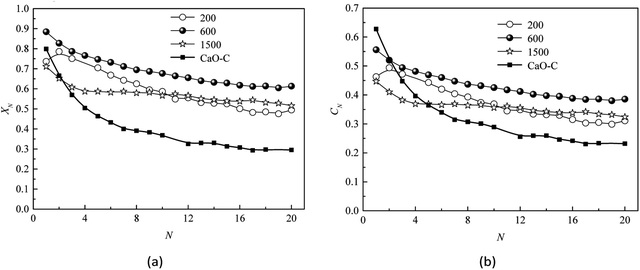 |
| | Fig. 9 Effect of molecular weight of the polyethylene glycol on (a) carbonation conversion and (b) CO2 capture capacity of the MgO-stabilized CaO sorbent. | |
 |
| | Fig. 10 SEM and EDS analysis of the calcined MgO-stabilized CaO sorbent synthesized using PEG with different molecular weight: (a) PEG 200; (b) PEG 600; (c) PEG 1500. | |
3.3. Effect of synthesis temperature on CO2 capture capacity
The synthesis temperature was chosen as 700 °C, 750 °C and 850 °C in this research. The effect of synthesis temperature on CO2 capture capacity of the MgO-stabilized CaO sorbent was shown in Fig. 11. The MgO-stabilized CaO sorbent showed the highest CO2 capture capacity when the synthesis temperature was 750 °C. In the 1st cycle, when synthesized at 750 °C, the carbonation conversion of the MgO-stabilized CaO sorbents was 0.75, which was equal to the sorbent synthesized at 700 °C and 28.9% higher than that synthesized at 850 °C. After 20 cycles, when synthesized at 750 °C, the carbonation conversion of the MgO-stabilized CaO sorbents was 0.53, which was 18.7% and 12.2% higher than that synthesized at 700 °C and 850 °C. It has been proved that synthesizing under high temperature is helpful for the sorbent to form more stable microstructure during multiple calcination/carbonation cycles. So, initially increasing the synthesis temperature can enhance the microstructure of the sorbent. However, if the synthesis temperature is higher than the optimum temperature, severe pre-sintering will occur during the synthetic process, decreasing the CO2 capture capacity of the sorbent. To sum up, the optimum synthesis temperature is 750 °C.
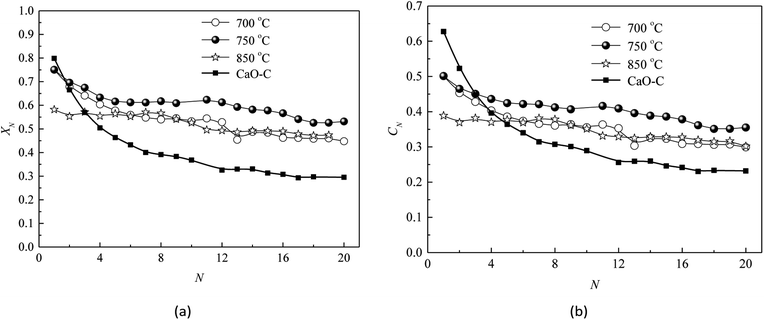 |
| | Fig. 11 Effect of synthesis temperature on (a) carbonation conversion and (b) CO2 capture capacity of MgO-stabilized CaO sorbent. | |
3.4. Effect of synthesis time on CO2 capture capacity
The effect of synthesis time on CO2 capture capacity of the MgO-stabilized CaO sorbent was shown in Fig. 12. If the synthesis time is too short, the combustible material in the solution can not burn out during the synthesis process. It need about 30 min for the PEG in the solution to finish its combustion. Go on lengthening the synthesis time will lead more severe pre-sintering of the sorbent, which is adverse for the CO2 capture. The experimental test results in the DFR also proved this conclusion. The CO2 capture capacity of the MgO-stabilized CaO sorbent slightly decreased when the synthesis time lengthened from 30 min to 120 min. After 20 cycles, the CO2 capture capacity of the MgO-stabilized CaO sorbent reduced by 14.4% when the synthesis time lengthened from 30 min to 120 min. Therefore, 30 min is the optimum synthesis time when synthesizing the MgO-stabilized CaO sorbent.
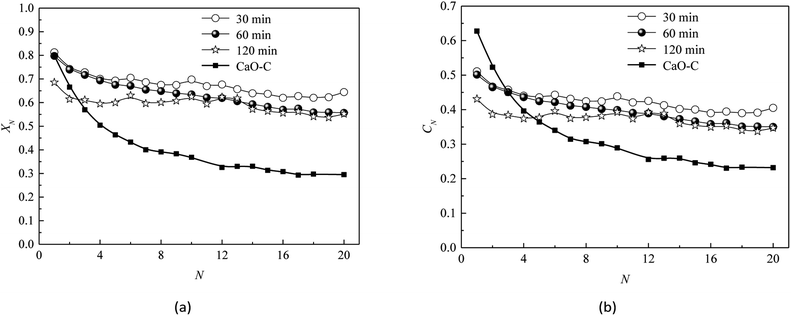 |
| | Fig. 12 Effect of the Synthesis time on (a) carbonation conversion and (b) CO2 capture capacity of MgO-stabilized CaO sorbent. | |
4. Conclusions
In this research, using polyethylene glycol as the fuel and dispersant, solution combustion method was employed to synthesize MgO-stabilized CaO sorbents by soluble MgO and CaO precursors. The main conclusions are presented as follows:
(1) A kind of highly reactive MgO-stabilized CaO sorbents was obtained through solution combustion method using PEG as fuel and dispersant. The Ca and Mg distributed homogeneously on the surface of the MgO-stabilized CaO sorbents. The existence of MgO can effectively restrain the sintering of the sorbent, resulting in a more porous and stable microstructure of the sorbent. The microstructure is benefit to the CO2 diffusion and the carbonation reaction. That's why the MgO-stabilized CaO sorbents can achieve so high CO2 capture capacity.
(2) The synthetic conditions including Ca/Mg molar ratio, molecular weight of PEG, synthesis time and synthesis temperature have apparent effects on the CO2 capture capacity of the MgO-stabilized CaO sorbents. The optimum synthetic conditions obtained this research: the optimum Ca/Mg molar ratio is 8![[thin space (1/6-em)]](https://www.rsc.org/images/entities/char_2009.gif) :
:![[thin space (1/6-em)]](https://www.rsc.org/images/entities/char_2009.gif) 2; the optimum molecular weight of PEG is 600; the optimum synthesis temperature and time are 750 °C and 30 min respectively. The CO2 capture capacity of the MgO-stabilized CaO sorbent synthesized under the optimum conditions is 0.40 g(CO2)/g(sorbent) after 20 cycles, which is 75.3% higher than CaO–C.
2; the optimum molecular weight of PEG is 600; the optimum synthesis temperature and time are 750 °C and 30 min respectively. The CO2 capture capacity of the MgO-stabilized CaO sorbent synthesized under the optimum conditions is 0.40 g(CO2)/g(sorbent) after 20 cycles, which is 75.3% higher than CaO–C.
Conflicts of interest
There are no conflicts to declare.
Acknowledgements
This research was supported by National Natural Science Foundation of China (51706094), Jiangsu Province Science and Technology Plan Special Fund (BZ2022053), Innovation Fund of Nanjing Institute of Technology (CKJA202202) and the Open Research Fund of NJIT Research Center, The Key Laboratory of Carbon Neutrality and Territory Optimization, Ministry of Natural Resources (CNT202202).
References
- X. Zhao, X. Ma, B. Chen, Y. Shang and M. Song, Challenges toward carbon neutrality in China: Strategies and countermeasures, Resour., Conserv. Recycl., 2022, 176, 105959 CrossRef CAS
 .
. - Y. Wei, K. Chen, J. Kang, W. Chen, X. Wang and X. Zhang, Policy and Management of Carbon Peaking and Carbon Neutrality: A Literature Review, Engineering-PRC, 2022, 14, 52–63 CAS
 .
. - S. B. Mousavi, M. Heidari, F. Rahmani, R. A. Sene, T. C. Peter and O. Serap, Highly robust ZrO2-stabilized CaO nano adsorbent prepared via a facile one-pot MWCNT-template method for CO2 capture under realistic calcium looping conditions, J. Cleaner Prod., 2023, 384, 135579 CrossRef CAS
 .
. - K. Wang, J. Chen, T. Wang, J. Hong, P. zhao and E. J. Edward, Catalytic calcium-looping gasification of biochar with in situ CO2 utilization with improved energy efficiency, Chem. Eng. J., 2023, 144857 CrossRef CAS
 .
. - Y. Wang, Y. Li, L. Yang, X. Fan and L. Chu, Ca12Al14O33 or MgO supported Ni-carbide slag bi-functional materials for H2 production and CO2 capture in sorption-enhanced steam gasification of cellulose/polyethylene mixture, Fuel, 2022, 328, 125209 CrossRef CAS
 .
. - R. Sun, R. Xiao and J. Ye, Kinetic analysis about the CO2 capture capacity of lime mud from paper mill in calcium looping process, Energy Sci. Eng., 2020, 8(11), 4014–4024 CrossRef CAS
 .
. - T. Luo, C. Luo, Z. Shi, X. Li, F. Wu and L. Zhang, Optimization of sol-gel combustion synthesis for calcium looping CO2 sorbents, part I: effects of sol-gel preparation and combustion conditions, Sep. Purif. Technol., 2022, 292, 121081 CrossRef CAS
 .
. - J. Wang, P. Wu, Y. Wei, Q. Zhao, P. Ning, Y. Huang, S. Wen, J. Xu and Q. Wang, Study of calcium-based CO2 sorbent with high cycling stability derived from steel slag and its anti-sintering mechanism, J. CO2 Util., 2022, 66, 102279 CrossRef CAS
 .
. - J. C. Abanades and D. Alvarez, Conversion Limits in the Reaction of CO2 with Lime, Energy Fuels, 2003, 17, 308–315 CrossRef CAS
 .
. - P. Sun, J. R. Grace, C. J. Lim and E. J. Anthony, The effect of CaO sintering on cyclic CO2 capture in energy systems, AIChE J., 2007, 53(9), 2432–2442 CrossRef CAS
 .
. - J. Blamey, E. J. Anthony, J. Wang and P. S. Fennell, The calcium looping cycle for large-scale CO2 capture, Prog. Energy Combust. Sci., 2010, 36, 260–279 CrossRef CAS
 .
. - Y. Hu, W. Liu, J. Sun, M. Li, X. Yang, Y. Zhang, X. Liu and M. Xu, Structurally improved CaO-based sorbent by organic acids for high temperature CO2 capture, Fuel, 2016, 167, 17–24 CrossRef CAS
 .
. - J. Sun, Y. Yang, Y. Guo, Y. Xu, W. Li, C. Zhao, W. Liu and P. Lu, Stabilized CO2 capture performance of wet mechanically activated dolomite, Fuel, 2018, 222, 334–342 CrossRef CAS
 .
. - M. Li, C. Shen, J. Ji, L. Li and Y. Wu, Multiple activation mechanisms of CaO-based sorbents promoted by pre-sintering-hydration, J. Environ. Chem. Eng., 2022, 10(5), 108216 CrossRef CAS
 .
. - G. Belén, J. Blamey, M. J. Al-Jeboori, N. H. Florin, P. T. Clough and P. S. Fenell, Additive effects of steam addition and HBr doping for CaO-based sorbents for CO2 capture, Chem. Eng. Process., 2016, 103, 21–26 CrossRef
 .
. - D. Karami and N. Mahinpey, Highly active CaO-based sorbents for CO2 capture using the precipitation method: preparation and characterization of the sorbent powder, Ind. Eng. Chem. Res., 2012, 51(12), 4567–4572 CrossRef CAS
 .
. - S. M. Hashemi, R. Zhou and N. Mahinpey, Evaluation of MgO- and CaZrO3-promoted CaO-based pellets produced via solution combustion synthesis, Chem. Eng. J., 2022, 450, 138274 CrossRef CAS
 .
. - X. Ma, X. Huang, H. Zhang, X. Hu and T. Feng, Effect of calcium aluminates on the structure evolution of CaO during the calcium looping process: a DFT study, Chem. Eng. J., 2023, 452, 139552 CrossRef CAS
 .
. - J. Chen, L. Duan and Z. Sun, Review on the development of sorbents for calcium looping, Energy Fuels, 2020, 34(7), 7806–7836 CrossRef CAS
 .
. - P. Lan and S. Wu, Synthesis of a Porous Nano-CaO/MgO-Based CO2 Adsorbent, Chem. Eng. Technol., 2014, 37(4), 580–586 CrossRef CAS
 .
. - N. M. Awais, A. Andac, I. Qasim, F. Donat, R. Schäublin, A. Kierzkowska and C. R. Müller, Optimization of the structural characteristics of CaO and its effective stabilization yield high-capacity CO2 sorbents, Nat. Commun., 2018, 9(1), 2408–2418 CrossRef
 .
. - X. Yan, Y. Li, X. Ma, J. Zhao, W. Zhang and H. Liu, CO2 capture by a novel CaO/MgO sorbent fabricated from industrial waste and dolomite at calcium looping conditions, New J. Chem., 2019, 43, 5116–5125 RSC
 .
. - X. Ma, Y. Li, C. Zhang and Z. Wang, Development of Mn/Mg-copromoted carbide slag for efficient CO2 capture under realistic calcium looping conditions, Process Saf. Environ. Prot., 2020, 141, 380–389 CrossRef CAS
 .
. - L. Zhang, Q. Lin, B. Cheng, P. Wang, M. Lu and Q. Lin, Effect of hexanitroethane (HNE) and hydrazinium nitroformate (HNF) on energy characteristics of composite solid propellants, FirePhysChem, 2021, 1, 116–122 CrossRef
 .
. - R. Sun, H. Zhu and R. Xiao, Enhancement of CO2 capture and microstructure evolution of the spent calcium-based sorbent by the self-reactivation process, Chin. J. Chem. Eng., 2021, 29, 160–166 CrossRef CAS
 .
. - Y. Li, R. Sun, C. Liu, H. Liu and C. Lu, CO2 capture by carbide slag from chlor-alkali plant in calcination/carbonation cycles, Int. J. Greenhouse Gas Control, 2012, 9, 117–123 CrossRef
 .
. - Y. A. Criado, B. Arias and J. C. Abanades, Effect of the Carbonation Temperature on the CO2 Carrying Capacity of CaO, Ind. Eng. Chem. Res., 2018, 57, 12595–12599 CrossRef CAS
 .
.
|
| This journal is © The Royal Society of Chemistry 2024 |
Click here to see how this site uses Cookies. View our privacy policy here.  Open Access Article
Open Access Article *ab,
Hao Shena,
Xun Lvc,
Yichen Wanga and
Tianjiao Hua
*ab,
Hao Shena,
Xun Lvc,
Yichen Wanga and
Tianjiao Hua
![[thin space (1/6-em)]](https://www.rsc.org/images/entities/char_2009.gif) :
:![[thin space (1/6-em)]](https://www.rsc.org/images/entities/char_2009.gif) 3
3![[thin space (1/6-em)]](https://www.rsc.org/images/entities/char_2009.gif) :
:![[thin space (1/6-em)]](https://www.rsc.org/images/entities/char_2009.gif) 2
2![[thin space (1/6-em)]](https://www.rsc.org/images/entities/char_2009.gif) :
:![[thin space (1/6-em)]](https://www.rsc.org/images/entities/char_2009.gif) 1
1![[thin space (1/6-em)]](https://www.rsc.org/images/entities/char_2009.gif) :
:![[thin space (1/6-em)]](https://www.rsc.org/images/entities/char_2009.gif) 3
3![[thin space (1/6-em)]](https://www.rsc.org/images/entities/char_2009.gif) :
:![[thin space (1/6-em)]](https://www.rsc.org/images/entities/char_2009.gif) 3
3![[thin space (1/6-em)]](https://www.rsc.org/images/entities/char_2009.gif) :
:![[thin space (1/6-em)]](https://www.rsc.org/images/entities/char_2009.gif) 3
3![[thin space (1/6-em)]](https://www.rsc.org/images/entities/char_2009.gif) :
:![[thin space (1/6-em)]](https://www.rsc.org/images/entities/char_2009.gif) 3
3![[thin space (1/6-em)]](https://www.rsc.org/images/entities/char_2009.gif) :
:![[thin space (1/6-em)]](https://www.rsc.org/images/entities/char_2009.gif) 3
3![[thin space (1/6-em)]](https://www.rsc.org/images/entities/char_2009.gif) :
:![[thin space (1/6-em)]](https://www.rsc.org/images/entities/char_2009.gif) 3
3

![[thin space (1/6-em)]](https://www.rsc.org/images/entities/char_2009.gif) :
:![[thin space (1/6-em)]](https://www.rsc.org/images/entities/char_2009.gif) 1 to 7
1 to 7![[thin space (1/6-em)]](https://www.rsc.org/images/entities/char_2009.gif) :
:![[thin space (1/6-em)]](https://www.rsc.org/images/entities/char_2009.gif) 3, the MgO-stabilized CaO sorbents were synthesized by solution combustion method. The solution combustion synthesis temperature and time were 750 °C and 60 min and the molecular weight of the polyethylene glycol is 600 in this case. The DFR test results were shown in Fig. 5. It can be seen that the MgO-stabilized CaO sorbents shows much higher and more stable CO2 capture capacity compared with that of the CaO–C. In the 20th cycle, the carbonation conversions of the MgO-stabilized CaO sorbents were 0.57, 0.53 and 0.42 when the Ca/Mg molar ratio were 7
3, the MgO-stabilized CaO sorbents were synthesized by solution combustion method. The solution combustion synthesis temperature and time were 750 °C and 60 min and the molecular weight of the polyethylene glycol is 600 in this case. The DFR test results were shown in Fig. 5. It can be seen that the MgO-stabilized CaO sorbents shows much higher and more stable CO2 capture capacity compared with that of the CaO–C. In the 20th cycle, the carbonation conversions of the MgO-stabilized CaO sorbents were 0.57, 0.53 and 0.42 when the Ca/Mg molar ratio were 7![[thin space (1/6-em)]](https://www.rsc.org/images/entities/char_2009.gif) :
:![[thin space (1/6-em)]](https://www.rsc.org/images/entities/char_2009.gif) 3, 8
3, 8![[thin space (1/6-em)]](https://www.rsc.org/images/entities/char_2009.gif) :
:![[thin space (1/6-em)]](https://www.rsc.org/images/entities/char_2009.gif) 2 and 9
2 and 9![[thin space (1/6-em)]](https://www.rsc.org/images/entities/char_2009.gif) :
:![[thin space (1/6-em)]](https://www.rsc.org/images/entities/char_2009.gif) 1, while the value for CaO–C was only 0.29. Take the MgO-stabilized CaO sorbent with Ca/Mg molar ratio is 7
1, while the value for CaO–C was only 0.29. Take the MgO-stabilized CaO sorbent with Ca/Mg molar ratio is 7![[thin space (1/6-em)]](https://www.rsc.org/images/entities/char_2009.gif) :
:![[thin space (1/6-em)]](https://www.rsc.org/images/entities/char_2009.gif) 3 as example, the SEM and EDS analysis were conducted to determine the element distribution on the surface of the sorbent, as shown in Fig. 6. The SEM analysis result shown in Fig. 6(a) was employed to calculate the EDS spectrum and the result was shown in Fig. 6(d). According to the EDS spectrum, the Ca/Mg molar ratio on the surface of the sorbent was calculated as 6.95
3 as example, the SEM and EDS analysis were conducted to determine the element distribution on the surface of the sorbent, as shown in Fig. 6. The SEM analysis result shown in Fig. 6(a) was employed to calculate the EDS spectrum and the result was shown in Fig. 6(d). According to the EDS spectrum, the Ca/Mg molar ratio on the surface of the sorbent was calculated as 6.95![[thin space (1/6-em)]](https://www.rsc.org/images/entities/char_2009.gif) :
:![[thin space (1/6-em)]](https://www.rsc.org/images/entities/char_2009.gif) 2.97, which was agree with the synthesis process. It proved that the EDS result was accurate. The Ca and Mg distributions on the sorbent surface were shown in Fig. 6(b) and (c). It revealed a homogeneously evenly distribution of Ca and Mg on the surface of the sorbent. As shown in Fig. 7, the calcined MgO-stabilized CaO sorbents showed more porous microstructure compared with the CaO–C during the 1st cycle. The existence of MgO can effectively restrain the sintering of the sorbent. As shown in Fig. 8, the calcined MgO-stabilized CaO sorbents can maintain effective enough pore structure for CO2 diffusion in the sorbent, while CaO–C occurred obvious sintering after 20 cycles. Thus, the MgO-stabilized CaO sorbents showed higher and more stable CO2 capture capacity compared with CaO–C.
2.97, which was agree with the synthesis process. It proved that the EDS result was accurate. The Ca and Mg distributions on the sorbent surface were shown in Fig. 6(b) and (c). It revealed a homogeneously evenly distribution of Ca and Mg on the surface of the sorbent. As shown in Fig. 7, the calcined MgO-stabilized CaO sorbents showed more porous microstructure compared with the CaO–C during the 1st cycle. The existence of MgO can effectively restrain the sintering of the sorbent. As shown in Fig. 8, the calcined MgO-stabilized CaO sorbents can maintain effective enough pore structure for CO2 diffusion in the sorbent, while CaO–C occurred obvious sintering after 20 cycles. Thus, the MgO-stabilized CaO sorbents showed higher and more stable CO2 capture capacity compared with CaO–C.


![[thin space (1/6-em)]](https://www.rsc.org/images/entities/char_2009.gif) :
:![[thin space (1/6-em)]](https://www.rsc.org/images/entities/char_2009.gif) 3 (a) SEM imagine; (b) Mg distribution; (c) Ca distribution; (d) EDS spectra.
3 (a) SEM imagine; (b) Mg distribution; (c) Ca distribution; (d) EDS spectra.
![[thin space (1/6-em)]](https://www.rsc.org/images/entities/char_2009.gif) :
:![[thin space (1/6-em)]](https://www.rsc.org/images/entities/char_2009.gif) 3; (b) Ca/Mg molar ratio is 8
3; (b) Ca/Mg molar ratio is 8![[thin space (1/6-em)]](https://www.rsc.org/images/entities/char_2009.gif) :
:![[thin space (1/6-em)]](https://www.rsc.org/images/entities/char_2009.gif) 2; (c) Ca/Mg molar ratio is 9
2; (c) Ca/Mg molar ratio is 9![[thin space (1/6-em)]](https://www.rsc.org/images/entities/char_2009.gif) :
:![[thin space (1/6-em)]](https://www.rsc.org/images/entities/char_2009.gif) 1.
1.
![[thin space (1/6-em)]](https://www.rsc.org/images/entities/char_2009.gif) :
:![[thin space (1/6-em)]](https://www.rsc.org/images/entities/char_2009.gif) 3; (b) Ca/Mg molar ratio is 8
3; (b) Ca/Mg molar ratio is 8![[thin space (1/6-em)]](https://www.rsc.org/images/entities/char_2009.gif) :
:![[thin space (1/6-em)]](https://www.rsc.org/images/entities/char_2009.gif) 2; (c) Ca/Mg molar ratio is 9
2; (c) Ca/Mg molar ratio is 9![[thin space (1/6-em)]](https://www.rsc.org/images/entities/char_2009.gif) :
:![[thin space (1/6-em)]](https://www.rsc.org/images/entities/char_2009.gif) 1.
1.![[thin space (1/6-em)]](https://www.rsc.org/images/entities/char_2009.gif) :
:![[thin space (1/6-em)]](https://www.rsc.org/images/entities/char_2009.gif) 2 represents higher CO2 capture capacity from the 10th cycle. Therefore, the optimum Ca/Mg molar ratio is 8
2 represents higher CO2 capture capacity from the 10th cycle. Therefore, the optimum Ca/Mg molar ratio is 8![[thin space (1/6-em)]](https://www.rsc.org/images/entities/char_2009.gif) :
:![[thin space (1/6-em)]](https://www.rsc.org/images/entities/char_2009.gif) 2.
2.



![[thin space (1/6-em)]](https://www.rsc.org/images/entities/char_2009.gif) :
:![[thin space (1/6-em)]](https://www.rsc.org/images/entities/char_2009.gif) 2; the optimum molecular weight of PEG is 600; the optimum synthesis temperature and time are 750 °C and 30 min respectively. The CO2 capture capacity of the MgO-stabilized CaO sorbent synthesized under the optimum conditions is 0.40 g(CO2)/g(sorbent) after 20 cycles, which is 75.3% higher than CaO–C.
2; the optimum molecular weight of PEG is 600; the optimum synthesis temperature and time are 750 °C and 30 min respectively. The CO2 capture capacity of the MgO-stabilized CaO sorbent synthesized under the optimum conditions is 0.40 g(CO2)/g(sorbent) after 20 cycles, which is 75.3% higher than CaO–C..
.
.
.
.
.
.
.
.
.
.
.
.
.
.
.
.
.
.
.
.
.
.
.
.
.
.




